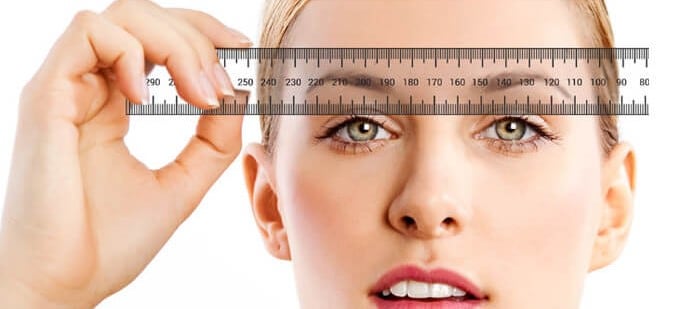A GUIDE TO DETERMINING PUPILLARY DISTANCE
The millimeter is the standard measurement unit used in the industry for determining the optical center of corrective lenses.
An optometrist or optical assistant may measure pupillary distances with either a machine – a “corneal reflex pupillometer” – or with a millimeter ruler. If you are careful, you can also measure pupillary distance with a small ruler at home. It is not necessary for pupillary distance measurements to be 100 percent accurate in order for them to be useful, since they can tolerate relatively small errors. The best way to ensure that your pupillary distance is fairly accurate is to make several attempts at measuring it.
AREA OF MEASUREMENT
These are the typical ranges for various groups of measurements to give you an idea of what you should be expecting:
-
The average pupillary distance in adults ranges between 54 and 68 millimeters, with acceptable measurements deviating between 48 and 73 millimeters.
-
It is estimated that the range for children will be between 41 and 55mm.
-
A small minority (5 percentile) of adult males in the UK measure 55mm while a large majority (95 percentile) measure 70mm.
-
It is typically between 65mm and 53mm for adult females in the United Kingdom.
-
Compared to the measurements above, the figures for Europeans are approximately 1mm smaller.
Precision in pupillary distance: An integral part of a clear vision
In order to order prescription glasses accurately, your pupillary distance (PD) must be accurate. You may experience vision problems with the new glasses if the prescription information entered is incorrect, including an inaccurate pupillary distance measurement.
Precision in PDs ensures optimal vision clarity, and deviations from the accurate measurement may result in discomfort or difficulty concentrating. Your new glasses will be less effective if the correct information is provided, as errors in prescription details can negatively impact their effectiveness, regardless of whether they are obtained from an optometrist or self-measured.
RX Safety guarantees that the prescription safety glasses we produce will precisely meet the specifications you provide, but we also emphasize that you are responsible for submitting accurate information. It is important to double-check measurements and ensure that the information aligns with the prescription recommendations of your eye care professional as we cannot be held responsible for errors in prescription details.
By measuring your lenses accurately, you will not only be able to ensure that they align perfectly with your prescription but will also enjoy a more comfortable and enjoyable visual experience. Consider seeking assistance from another person if necessary, to ensure that the measurement is as accurate as possible to ensure a seamless eyewear experience.
















